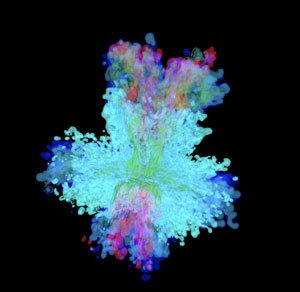A supernova in a nearby galaxy may have originated from an explosion of a blue supergiant formed by the merger of two stars, simulations by RIKEN astrophysicists suggest. The asymmetric nature of this explosion may provide hints for where to look for the elusive neutron star birthed in this stellar cataclysm.
A core-collapse supernova occurs when the core of a massive star can no longer withstand its own gravity. The core collapses in on itself, triggering a violent explosion that blasts away the star’s outer layers, leaving behind a neutron star or black hole.
In 1987, astronomers saw a star explode in the Large Magellanic Cloud, one of our galaxy’s closest neighbors. Since then, scientists have intensively studied the aftermath of this supernova, known as SN 1987A, to understand the nature of the progenitor star and its fate.
The progenitor of this type of supernova is usually a red supergiant, but observations have shown that SN 1987A was caused by a compact blue supergiant. “It has been a mystery why the progenitor star was a blue supergiant,” says Masaomi Ono at the RIKEN Astrophysical Big Bang Laboratory.
Meanwhile, X-ray and gamma-ray observations of SN 1987A have revealed clumps of radioactive nickel in the ejected matter. This nickel was formed in the star’s core during its collapse, and is now hurtling away from the star at speeds of more than 4,000 kilometers per second. Previous simulations of the supernova had been unable to fully explain how this nickel could escape so rapidly.
Find your dream job in the space industry. Check our Space Job Board »
Ono and co-workers simulated asymmetric core-collapse supernova explosions of four progenitor stars and compared them with observations of SN 1987A. The closest match involved a blue supergiant progenitor formed by a merger between two stars: a red supergiant and a main-sequence star. During the merger, the larger star would have stripped matter from its smaller companion, which spiraled inward until it was completely absorbed, forming a rapidly rotating blue supergiant.
This is the first time that a binary-merger scenario has been tested for the nickel clumping of this supernova, Ono says. The simulation accurately reproduced the speeding clumps of nickel along with two jets of ejecta.
The simulation may also help to find the neutron star that formed during the supernova, which has not been located despite 30 years of searching. In an aspherical explosion, the neutron star could have been kicked in the opposite direction to the bulk of the ejecta, and Ono’s team suggests that astronomers should look for it in the northern part of the inner region of ejected material.
Provided by: RIKEN
More information: Masaomi Ono et al. Matter Mixing in Aspherical Core-collapse Supernovae: Three-dimensional Simulations with Single-star and Binary Merger Progenitor Models for SN 1987A. The Astrophysical Journal (2020). DOI: 10.3847/1538-4357/ab5dba
Image: Figure 1: This computer simulation of a supernova shows how matter is ejected from the heart of an exploding star.
Credit: RIKEN Astrophysical Big Bang Laboratory
